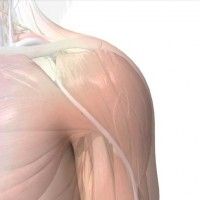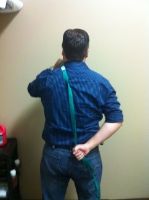The shoulder is an extremely flexible joint allowing us to move the shoulder in directions like no other joint. This flexibility is what allows us to do things like paint a ceiling or  pitch a baseball.
pitch a baseball.
To have this great flexibility the shoulder can become unstable. The shoulder is connected to the body by ligaments and muscles, and has a lot of mobility; however, it is one of the most unstable joints in the body.
What’s your risk?
It used to be believed that you only had a painful shoulder from a rugged job or if you played a lot of sports. These activities generally required a lot of shoulder mobility and flexibility and included the following:
- Overhead athletes, like tennis players, swimmers, baseball pitchers
- Painters
- Construction workers
- Movers
That said, we are treating the painful shoulder across the spectrum including middle/high school non-athletes, stay at home parents (both mom and dad), and active adults that all report that they are not sure why they have a painful shoulder or when they may have hurt it.
Common symptoms reported by our clients include:
- Pain when raising the arm
- Pain that persists beyond a few days
- Swelling or bruising around the arm
- Pain when leaning on, or sleeping on the affected shoulder
- Weakness in the arm that stops you from lifting a grocery bag, reaching up, or pushing open a heavy door
- Having difficulty or being unable to carry your child
- Inability to use the arm
- Pain that they can’t touch or seem to locate
- Inability to reach behind them for self cleaning or dressing (fastening bra strap)
Most common question asked by our clients – How did I get a Painful Shoulder
Due to the great mobility of the shoulder and that we use our arms for most all tasks completed throughout our day, overuse from repetitive activities is the most common reason shoulders get painful. Acute trauma is the second most common cause of shoulder pain. This can occur from falls landing directly on the shoulder or landing on the out stretched arm.
The concept of repetitive stress/overuse is a difficult one to grasp as it relates the shoulder for most of our clients and is a big source of the “AAHH’s” as we are completing the evaluation and discover the destructive force. These destructive forces, as we label them at Valeo PT, can be prolonged sitting, prolonged mouse use, driving, poor posture, excessive smartphone use, or any other activity that requires a sustained position or a repetitive movement. Now let’s be clear that these activities by them selves do not cause the problem, but the sustained, repetitive, and day after day completion of these activities presents a compound effect. This means that each time you do these activities and had that stress to the tissues stacks on top of the previous days stress. Then “one day”, “out of no where” you have shoulder pain and you don’t know why.
Repetitive activities lead to repetitive stress injuries and this can be as simple as using a computer or your smartphone. Also, too much wear and tear of the shoulder muscles and the joint capsule, or even UNDERUSE of the arm itself, can lead to frozen shoulder.
If you suffer from any of the symptoms mentioned above, call our office today. Relief is just a phone call away!
Your Physical Therapist – A Shoulder To Lean On
Stress on your shoulder is one of the most common causes of shoulder injury, but one of the most overlooked reasons for shoulder injury is inactivity. When you don’t use the muscles regularly, they become weaker. The phrase “If you don’t use it, you lose it” is applicable to muscles.
If you don’t exercise the full range of your shoulder through moderate-intensity exercise, the risk of hurting your shoulder increases. Ligaments tighten, muscles weaken, and blood flow becomes inhibited. Over time, this can accelerate joint degeneration and trigger shoulder pain.
We have the solution
- Regular exercise (power walking with good arm movement, swimming, golf, tennis) may minimize the onset and severity of shoulder pain.
- Proper body mechanics – this can be counterintuitive. Ask your therapist if your body mechanics need to be corrected.
- Strength and Flexibility– balanced muscles of the shoulder, chest, upper back, and abdominals help keep your shoulder joints well-aligned and pain free.
Remember, common sense is the best line of defense against hurting your shoulder. It is important to not push yourself too much, especially if there is discomfort. Don’t do too much activity too soon. If you experience ANY pain in your shoulder with any activity, stop! If it is MILD, use ice for 10-15 minutes and rest your shoulder. If pain persists for more than 1-2 days, call your doctor or physical therapist. Don’t ignore the pain.
Be wary of…
Some exercises or movements can put excess stress and strain on shoulder structures and place increased strain on the rotator cuff tendon. Nicely discussed here!
The number 1 worse exercise is the hand behind the back “stretch” or pulling arm up behind back or using a towel to stretch up the back. This exercise places too much tension on the rotator cuff tendon or the surgical repair if you are recovering from surgery. Ask a lot of questions if any one suggests this exercise.
the rotator cuff tendon or the surgical repair if you are recovering from surgery. Ask a lot of questions if any one suggests this exercise.
The quicker the problem is addressed, the sooner you can begin healing and returning to your favorite activities.
We are here to serve you and help you achieve a speedy recovery as quickly as possible. We’ll give you a shoulder to lean on, so you have a healthy, pain free shoulder!

